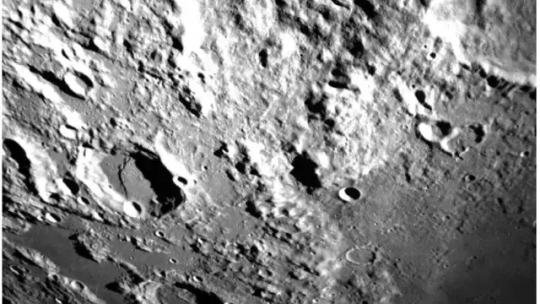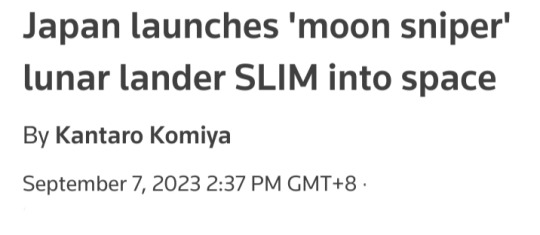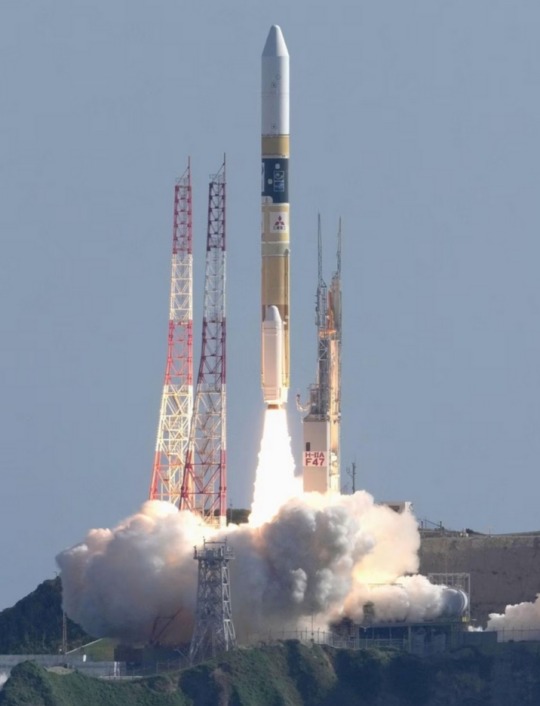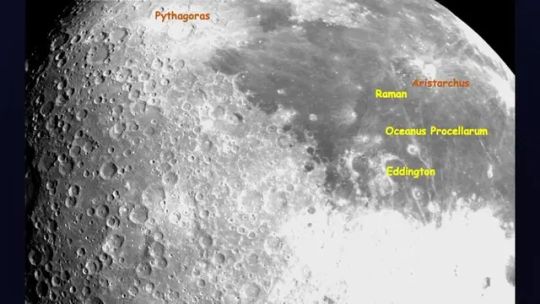#Chandrayaan programme
Explore tagged Tumblr posts
Text
How to Watch India's Chandrayaan-3 Moon Landing
India’s Chandrayaan-3 mission is aiming for a landing spot on the lunar south pole, hoping to make history as the nation’s first successful touchdown on the cratered surface. First Full-Color Images From Webb Space Telescope Chandrayaan-3 is scheduled to land on the Moon on Wednesday at 8:34 a.m. ET (6:04 p.m. local time in India). The Indian Space Research Organization (ISRO) will provide a…

View On WordPress
#Chandrayaan programme#Chandrayaan-2#Chandrayaan-3#Gizmodo#In India#In spaceflight#Indian lunar exploration programme#Internet#Luna 25#Lunar rovers#Lunar south pole#Moon landing#Pragyan#Rover#Technology#Vikram
2 notes
·
View notes
Text

The image of Indian Chandrayaan 3 before launch on 14 July 2023. Chandrayaan 3 is an Indian space exploration mission that aims to explore the moon. The Chandrayaan 3 is a follow-up of Chandrayaan 2. The mission is still in progress and is expected to land on the moon on 23 August 2023. If you want to know more about Chandrayaan 3, Visit My Article.
2 notes
·
View notes
Note
what do you think about this whole chandrayaan shtick
most of ISRO's engineering and scientific work is not really cutting edge, including this mission. 90% of the function of space programmes is propaganda and its so fucking hilarious that we spent all this money to come 4th. all of this is secondary to the fact that this is being sold as a win for hindutva fascists and will be invoked as defense when they defund public universities, gut research budgets and claim at the indian science congress that ancient india invented plastic surgery in hindu mythology. everyone read meera nanda science in saffron.
70 notes
·
View notes
Text


TOKYO, Sept 7 (Reuters) - Japan launched its lunar exploration spacecraft on Thursday aboard a homegrown H-IIA rocket, hoping to become the world's fifth country to land on the moon early next year.
Japan Aerospace Exploration Agency (JAXA) said the rocket took off from Tanegashima Space Center in southern Japan as planned and successfully released the Smart Lander for Investigating Moon (SLIM).
Unfavourable weather led to three postponements in a week last month.
Dubbed the "moon sniper," Japan aims to land SLIM within 100 metres of its target site on the lunar surface.
The $100-million mission is expected to start the landing by February after a long, fuel-efficient approach trajectory.
"The big objective of SLIM is to prove the high-accuracy landing ... to achieve 'landing where we want' on the lunar surface, rather than 'landing where we can'," JAXA President Hiroshi Yamakawa told a news conference.

The launch comes two weeks after India became the fourth nation to successfully land a spacecraft on the moon with its Chandrayaan-3 mission to the unexplored lunar south pole.
Around the same time, Russia's Luna-25 lander crashed while approaching the moon.
Two earlier lunar landing attempts by Japan failed in the last year.
JAXA lost contact with the OMOTENASHI lander and scrubbed an attempted landing in November.
The Hakuto-R Mission 1 lander, made by Japanese startup ispace (9348.T), crashed in April as it attempted to descend to the lunar surface.

SLIM is set to touch down on the near side of the moon close to Mare Nectaris, a lunar sea that, viewed from Earth, appears as a dark spot.
Its primary goal is to test advanced optical and image processing technology.
After landing, the craft aims to analyse the composition of olivine rocks near the sites in search of clues about the origin of the moon. No lunar rover is loaded on SLIM.
Thursday's H-IIA rocket also carried the X-Ray Imaging and Spectroscopy Mission (XRISM) satellite, a joint project of JAXA, NASA and the European Space Agency.
The satellite aims to observe plasma winds flowing through the universe that scientists see as key to helping understand the evolution of stars and galaxies.

Mitsubishi Heavy Industries (7011.T) manufactured the rocket and operated the launch, which marked the 47th H-IIA rocket Japan has launched since 2001, bringing the vehicle's success rate close to 98%.
JAXA had suspended the launch of H-IIA carrying SLIM for several months while it investigated the failure of its new medium-lift H3 rocket during its debut in March.
Japan's space missions have faced other recent setbacks, with the launch failure of the Epsilon small rocket in October 2022, followed by an engine explosion during a test in July.
The country aims to send an astronaut to the moon's surface in the latter half of the 2020s as part of NASA's Artemis programme.
https://www.reuters.com/technology/space/japan-launches-rocket-carrying-moon-lander-slim-after-three-delays-2023-09-06/
youtube
Japan launches 'Moon Sniper' mission | AFP
7 September 2023
Japan's "Moon Sniper" mission blasted off Thursday as the country's space programme looks to bounce back from a string of recent mishaps, weeks after India's historic lunar triumph.
#H-IIA rocket#Japan#lunar exploration spacecraft#SLIM#moon sniper#Japan Aerospace Exploration Agency (JAXA)#Tanegashima Space Center#Smart Lander for Investigating Moon#Hiroshi Yamakawa#Hakuto-R Mission 1 lander#ispace#Mare Nectaris#X-Ray Imaging and Spectroscopy Mission (XRISM) satellite#JAXA#NASA#European Space Agency#Mitsubishi Heavy Industries#Artemis#space#space rocket#Youtube#Chandrayaan-3 mission#Luna-25 lander#India#Russia#moon#moon landing
25 notes
·
View notes
Text
Over the moon! 🇮🇳
Proud of our dedicated scientists at #ISRO for the successful launch of Chandrayaan-3 mission.
A whole new era begins in India's space exploration programme 🚀
11 notes
·
View notes
Link
#Chandrayaan-2#Chandrayaan-3#India'slunarexplorationachievements#ISRO#ISROChandrayaan-3mission#Lunarlandingcommunicationmilestone#VikramSarabhai
2 notes
·
View notes
Text
Is India aiming for the Moon again?
According to a report, India is interested in joining Russia’s lunar nuclear power plant initiative.
This comes in the aftermath of India’s successful Chandrayaan-3 mission which made it the first to make a soft landing on the south pole of the lunar surface.
India is making plans to set up its first space station, Bharatiya Antariksha Station (BAS), by 2035.
The country, which signed the Artemis Accords in 2023, also wants to put a human on the Moon by 2040. But what do we know about the programme? Why is it important?
What do we know?
As per Eurasian Times, the project is being spearheaded by Russian state nuclear energy firm Rosatom.
This is part of a bigger project to build a base on the Moon in partnership with China.
The idea behind the lunar nuclear power plant is to provide power to the base. The proposed plant will be a small one capable of generating around half a megawatt of energy.
TASS quoted Rosatom chief Alexey Likhachev as saying that both Moscow and New Delhi are keen to participate in the project.
Likhachev was quoted as saying at the Eastern Economic Forum, “The new solution that we are asked to implement is the option of a lunar nuclear power plant with an energy capacity of up to half a megawatt.”
“By the way, with the involvement of the international community, our Chinese and Indian partners are very interested in this. We are trying to lay the foundation for several international space projects,” Likhachev added.
Roscosmos in May announced that it had already begun working on the nuclear power plant.
It said the power plant would be established to the Moon by 2036.
0 notes
Text
Space Resources
I was going through some very old emails from the days of SEDS India and Moon Society, India. This is around 2010. There was a student at the Indian School of Mines, Dhanbad (with the email id - [email protected] that keeps bouncing then and now) who wanted to become a member. We wanted to take his help to understand the data from Chandrayaan-I’s Moon Mineralogy Mapper (M3). There is not much of an email trail but there is a mobile number.
ISM, Dhanbad
This reminded me of ISM itself. The Indian School of Mines, Dhanbad is an interesting place which could be the center of focus soon. ISM Dhanbad has been converted into an IIT, but I hope it maintains some of its character as a mine school. This school will very soon be a very important school for space companies and India’s space programme.
The principles of extraction may or may not differ much from Earth to other celestial bodies. So far we have only picked up rocks that were already on the surface of a celestial body. We have dug some holes on some celestial objects as well, but that was mostly to collect samples.
Evidence
I asked on Twitter/X if anyone at ISM, Dhanbad is working on extracting resources from celestial objects. I have not received a reply.
Anyone at @IITISM_DHANBAD working on mining/resource utilisation of Moon, Mars, or the asteroids?
— Pradeep | പ്രദീപ് (@pradx) April 10, 2024
India Today had reported in 2021 that they had plans to start courses on asteroid mining. There is no update about the same. They do now have a center for seabed mining but no center for asteroid mining.
In Edition 81 of The Takshashila Institution’s High Tech Geopolitics newsletter, Ashwin Prasad, Space Power Analyst, talks about the consensus emerging between the United States and China about resource utilization on the Moon.
In a recent episode of SparX podcast by Mukesh Bansal, Pixxel’s Awais Ahmed speaks about how we will begin by extracting water, before moving on to other things.
Why will this be important?
The consensus emerging between US and China shows how important extraction of space resources is going to be. India is one of the few countries that now has the capability to land on the Moon. But, we also need to build the capability for extracting resources, studying mineral resources, and using those resources on the Moon and back on Earth. ISM, Dhanbad could be the place where we start to learn how to do this and build companies which do this.
0 notes
Text
How Chandrayaan-3 achieved India’s lunar dream: ISRO Director reveals
How Chandrayaan-3 achieved India’s lunar dream: ISRO Director reveals @neosciencehub #neosciencehub #space #technology #science #AI #ISRO #NASA #csir #ngri #Chandrayaan3 #Success
CSIR-NGRI hosts New Year Day Lecture-2024 on India’s Space Prowess “Our Chandrayaan-3 mission had three main objectives: to demonstrate a soft landing on the Moon, to explore the lunar south pole region, and to conduct scientific experiments using the lander and the rover,” said Dr. ThirthaPratim Das, Director, Space Science Programme ISRO. Participating as chief guest in CSIR-National…

View On WordPress
#Chandrayaan-3 Success#CSIR-NGRI Event#featured#Indian Space Achievements#ISRO Director&039;s Lecture#Lunar South Pole Exploration#sciencenews#space
0 notes
Text
India's Lunar Mission Captures Images of Far Side of the Moon Ahead of Historic Landing
Image: ISRO Chandrayaan-3 is India’s second attempt to land on the Moon. The first attempt didn’t go so well: Chandrayaan-2 crashed on the Moon in September 2019 due to an issue with its braking thrusters. Chandrayaan-2 included a lander-rover duo, as well as an orbiter. The space agency lost contact with the Vikram lander when it was around 1.3 miles (2.1 kilometers) from the lunar surface,…

View On WordPress
#Chandrayaan programme#Chandrayaan-2#Chandrayaan-3#Gizmodo#In India#In spaceflight#Indian lunar exploration programme#Internet#Lander#Luna 25#Lunar lander#Lunar rovers#Lunar south pole#Moon#Moon landing#Technology#the Moon#Vikram
2 notes
·
View notes
Text
Chandrayaan – 3: India’s leap to the Moon
Chandrayaan is the third ambitious mission in the series of lunar missions of Chandrayaan programme. The Indian Space Research Organisation (ISRO) developed the missions. The successful landing of Chandrayaan – 3 made India the fourth country to reach the lunar surface and booked the record for being the first to land near the South Pole of the moon.
The ISRO’s Chairman S. Somnath said, “Everything is working very well. Chandrayaan-3, the lander, the rover is very healthy and all the five instruments on board have been switched on. And it’s giving beautiful data now.”

0 notes
Text
[ad_1] Introduction Chandrayaan-3 is the third and most up-to-date lunar Indian Area Analysis exploration mission beneath the Chandrayaan programme of ISRO. Ofcourse, Chandrayaan-3 isn't just an indication of India’s rising technical capabilities in house exploration but in addition goals to make vital scientific discoveries in an unexplored territory on Moon. As India’s Chandrayaan-3’s mission is on its solution to success, right here’s a flashback from a risk perspective of one of the profitable moon missions on the earth. The Apollo 11 mission is a permanent image of human achievement, marking the primary profitable moon touchdown in historical past. Behind this historic feat lies an intricate internet of threat administration methods that allowed NASA to navigate the complexities of house journey and make sure the security of the astronauts. On this article, we'll delve deep into the teachings realized from the Apollo 11 mission, exploring how NASA’s threat administration method formed its success and the way these classes might be utilized to varied domains. Complete Danger Identification: One of many foundational pillars of NASA’s threat administration method throughout Apollo 11 was the great identification of potential dangers. The mission encompassed a collection of intricate phases, from launch and lunar orbit to the lunar touchdown and the return to Earth. Every of those phases introduced forth a large number of dangers, each recognized and unexpected. Instance 1: Launch Dangers The launch of the Saturn V rocket was fraught with dangers. The explosive potential of the rocket’s gasoline and the intricacies of staging required cautious consideration. To mitigate these dangers, NASA engineers carried out in depth simulations and checks to make sure the rocket’s structural integrity and the reliability of its propulsion techniques. Instance 2: Lunar Touchdown Challenges Touchdown on the moon was an unprecedented endeavor, and the dangers had been magnified by the unknown lunar floor situations. The danger of a crash touchdown was vital. NASA tackled this by using the lunar module’s descent engine to manage the spacecraft’s pace and descent trajectory, permitting Neil Armstrong to pilot the module to a safer touchdown web site when he acknowledged the deliberate web site was strewn with boulders. Prioritizing and Categorizing Dangers: Not all dangers are equal when it comes to their potential influence. NASA employed a threat matrix to categorize dangers based mostly on their severity and chance. This categorization enabled the crew to prioritize their efforts and assets in the direction of addressing essentially the most crucial dangers. Instance 3: Danger Matrix for Astronaut Security Astronaut security was a paramount concern. The danger matrix helped NASA determine potential hazards that might jeopardize the astronauts’ lives. This included dangers associated to life assist techniques, radiation publicity, and gear failures. By specializing in high-impact, high-likelihood dangers, NASA ensured that the astronauts had been adequately protected all through the mission. Innovation and Inventive Downside-Fixing: The Apollo 11 mission demonstrated NASA’s distinctive capability for innovation and inventive problem-solving within the face of surprising challenges. Instance 4: The Lunar Module Pc Anomaly In the course of the lunar descent, the onboard laptop of the lunar module (LM) began receiving extra information than it might course of, triggering a number of alarms and threatening to abort the touchdown. Astronauts Neil Armstrong and Buzz Aldrin needed to shortly assess the scenario and decide to proceed the descent manually. Their means to adapt beneath strain exemplified the significance of human judgment and inventive considering as backup options. Growing Contingency Plans: A core aspect of Apollo 11’s threat administration technique was the event of contingency plans.
These plans had been crucial for making certain the protection of the astronauts and the success of the mission even within the face of surprising occasions. Instance 5: Abort Procedures The Apollo 11 spacecraft had well-defined abort procedures for various phases of the mission. Within the occasion of an emergency throughout launch, lunar orbit, or lunar touchdown, the crew might execute particular maneuvers to securely return to Earth or the command module. These procedures acted as lifelines, offering a transparent plan of action in case of crucial failures. Actual-time Monitoring and Adaptation: Apollo 11’s journey to the moon wasn’t a static, preplanned trajectory. It required steady real-time monitoring and flexibility to answer evolving dangers and challenges. Instance 6: Mid-Course Corrections In the course of the journey to the moon, the spacecraft sometimes required mid-course corrections to make sure correct trajectory. The mission management crew needed to analyze information, assess dangers, and calculate exact maneuvers to maintain the spacecraft on its meant path. This real-time adjustment highlighted the significance of monitoring and responsiveness. Studying from Failures: Tragedy struck NASA with the Apollo 1 accident, during which a cabin fireplace throughout a pre-launch check claimed the lives of astronauts Gus Grissom, Ed White, and Roger Chaffee. This incident emphasised the significance of studying from failures to boost threat administration. Instance 7: The Apollo 1 Tragedy The Apollo 1 catastrophe led NASA to overtake its method to security. The investigation into the incident resulted within the identification of design flaws and procedural inadequacies that contributed to the accident. NASA used this painful lesson to refine security protocols, enhance communication, and develop a security tradition that permeated subsequent missions. Conclusion The Apollo 11 mission stands as a testomony to human dedication, innovation, and risk management. The profitable moon touchdown was not merely a results of luck, however a fastidiously orchestrated dance of meticulous planning, adaptability, and a dedication to astronaut security. The danger administration classes realized from Apollo 11 proceed to resonate throughout industries, demonstrating the worth of thorough risk identification, artistic problem-solving, contingency planning, real-time adaptation, and studying from failures. As we forge forward into new frontiers, the legacy of Apollo 11 serves as a guiding mild for these looking for to handle dangers and obtain the extraordinary. [ad_2]
0 notes
Text
North-Eastern Hill University (NEHU) Students Shines at G20 University Connect Finale held at New Delhi. Rimiki Shylla, Student at NEHU had the privilege of addressing the audience alongside the Prime Minister. The G20 University Connect Finale was an initiative aimed at bridging the gap between academia and the world of international diplomacy. Hon’ble Prime Minister Shri. Narendra Modi ji addressed the programme and credited the happenings in India - Chandrayaan 3, BRICS, G20 summit to the youth and urged them “to think big”. https://themeghalayan.com/nehu-students-shine-at-g20-university-connect-finale-in-new-delhi/



0 notes
Text


Gate Way to Success Institute celebrates India's Landing on the Moon
Chandrayaan-3 is the third Indian lunar exploration mission under the Indian Space Research Organisation's Chandrayaan programme. It consists of a lander named Vikram and a rover named Pragyan, similar to those of the Chandrayaan-2 mission.
Chandrayaan-3 made India the first country to successfully land near the Moon's south pole - a region that has piqued the interests of scientists due to its unique characteristics.
Scientists think that the region near Moon's south pole is home to ancient pockets of ice water that could be useful in future crewed missions and even settlements on Earth's only natural satellite.
The Chandrayaan-3 landed on the lunar surface on August 23 at 6.04 PM IST. The mission cemented India as an elite space nation and could unlock secrets about the Moon.
Go to Our to the given links to Support us- #Website- Gateway2Success.In, #WhatsApp- +91 8851135978, #Gmail- [email protected]
#Chandrayaan3Success#DelhiNCR#IndependenceDay2023#India#delhi#up#noida#indirapuram#coaching#gatewaytosuccess#mbbsadmission#govtjobs#CBSE#Gateway2Success#Noida#UttarPradesh#vashali#National#govtjobs2023#newdelhi#delhincr#education#govtjob#govtschemes#govtexam#government
0 notes
Link
New Delhi (AFP) Aug 26, 2023 India's budget Moon landing is a model for other countries aspiring to develop their own space programmes, Prime Minister Narendra Modi said Saturday while praising the scientists behind the successful mission. Chandrayaan-3 - "Mooncraft" in Sanskrit - touched down on the lunar surface on Wednesday, making India the first nation to land an unmanned craft near the largely unexplored lunar s
0 notes
Text
Chandrayaan 3 : India's Lunar Exploration.
Chandrayaan-3 is the third and most recent Indian Moon Exploration programme conducted by The ISRO. The Chandrayaan-3 is similar to the Chandrayaan-2 consisting of lander named Vikram and rover named Pragyan. The propulsion module acted like an orbiter, which carried the lander and rover configuration until the spacecraft was in a 100-kilometer (62 mi) lunar orbit. Rover Pragyan A memorable day…

View On WordPress
0 notes